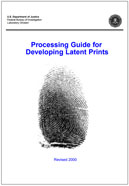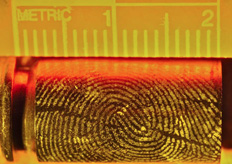|
View in browser: http://www.crime-scene-investigator.net/newsletter/0518.html
|
||
|
MAY 2018 | ||
| ||
|
This Month's Featured Resource on the Crime Scene Investigator Network Website
|
||

The beginning of this manual is a list of processes and procedures for different surface types. Also included are processing sequences that specifically involve prints that are left in blood. Following these lists are details for each process that is currently implemented in the Latent Print Unit (LPU) of the Federal Bureau of Investigation (FBI) Laboratory. |
||
|
Featured Video Presentation
|
||
|
Learn the basic technique for processing latent fingerprints by dusting with black powder. |
||
|
New CSI and Forensic Job Announcements
|
||
|
The most comprehensive listing of Crime Scene Investigation and Forensic To be notified of job openings as they are posted, follow us on Twitter: Job Posting Alerts |
||
|
Forensic Examiner I or II
Rapid City Police Department, Rapid City, South Dakota, USA Final Filing Date: May 29, 2018 Responds to major crime scenes; collects and analyzes evidence; preserves and documents crime scene and evidence through photography, measuring and scale drawings; prepares written reports. Operates analytical equipment and instruments using standard technical and scientific methods to perform specialized forensic examination of evidence and prepares written reports <View complete job listing> |
||
|
Crime Scene Investigator II
Denver Police Department, Denver, Colorado, USA Final Filing Date: May 30, 2018 Identifies, collects, preserves, packages, and presents biological evidence, latent fingerprints, tire impressions, shoe impressions, tool marks, and other physical evidence, provides support to crime scene investigations through blood spatter analysis, crime scene reconstruction analysis, ballistic and trajectory analysis and other specialized techniques that require detailed technical knowledge and training; <View complete job listing> |
||
|
Integrated Ballistics Identification System (IBIS) Technician
Institute of Forensic Sciences, Houston, Texas, USA Final Filing Date: June 9, 2018 Inventories, documents and evaluates various types of firearms for possible entry into the IBIS / NIBIN database. Test fires appropriate calibers and types of firearms. Conducts restoration of obliterated serial numbers on firearms. <View complete job listing> |
||
 |
||
|
DNA Analyst
Colorado Springs Police Department, Colorado Springs, Colorado, USA Final Filing Date: June 10, 2018 Perform serological testing and analyze body fluid stains and samples on a variety of evidence types related to various criminal cases. Perform forensic DNA analysis from DNA extraction, quantification, and PCR setup, through analysis using specialized analytical instrumentation to develop DNA profiles. Interpret analytical results of DNA testing through use of genetic typing software. <View complete job listing> |
||
|
Computer Forensic Analyst
Racine County Sheriff's Office, Racine, Wisconsin, USA Final Filing Date: May 31, 2018 Preview and analyze sensitive materials involving Crimes Against Children. More specifically, support members of the ICAC Unit with viewing and documenting highly sensitive video and data involving juveniles to ensure successful case outcomes. Provide investigative support by organizing and analyzing computerized information in computerized crime investigations. <View complete job listing> |
||
|
Latent Print Examiner
Tacoma Police Department, Tacoma, Washington, USA Final Filing Date: June 1, 2018 Develop, preserve, and transport recorded fingerprints, latent prints and evidence collected at crime scenes; prepare testimony and testify in courts of law; process evidence for latent prints using sophisticated chemical, physical, optical and computerized scientific analysis techniques; provide formal and informal training to law enforcement officers, staff and outside agencies in the collection and preservation of evidence. <View complete job listing> |
||
|
Search for more job listings in Crime Scene Investigations and Forensics To be notified of job openings as they are posted, follow us on Twitter: Job Posting Alerts |
||
|
Other Resources on the Crime Scene Investigator Network Website
|
||
|
Crime Scene Investigator mdash; Blog
Crime Scene Investigator Forum How to Become a Crime Scene Investigator Crime Scene Response Evidence Collection Crime Scene and Evidence Photography Crime Scene Investigation Articles Video Presentations College and University Programs Employment Resources and Links |
||
|
Not Subscribed to this Newsletter?
|
||
|
If you are not subscribed to this newsletter, you may subscribe with this link: SUBSCRIBE via email |
||
|
To Unsubscribe
|
||
|
To unsubscribe from future e-mail newsletters, please click here: UNSUBSCRIBE Copyright ©2018 Crime Scene Resources, Inc. Crime Scene Investigator Network |

 Cartridge casings found at crime scenes may contain fingerprint evidence to introduce or help convict a suspect; however, there are few articles on the subject of the best method to develop fingerprints on cartridge casings. The purpose of this research was to compare the best development methods for unfired casings found in previous research along with other commonly used development methods. After the most effected method was determined, that method was then applied to fired brass cartridge casings. Five different methods and five hundred unfired .40 caliber brass cartridge casings with one fingerprint on each were used. The two techniques that yielded the best results were cyanoacrylate fuming followed by gun blue followed by BY40 and cyanoacrylate fuming followed by BY40 followed by acidified hydrogen peroxide. The technique that produced the highest average of fingerprints of comparison value was cyanoacrylate fuming followed by gun blue followed by BY40; this method was the method chosen to be applied to the fired cartridge casings. Phase II consisted of firing fifty .40 caliber bullets from a .40 caliber handgun after one sebaceous fingerprint was placed on each casing. Although cyanoacrylate fuming followed by gun blue followed by BY40 yielded clear fingerprints with unfired casings, this method did not produce any clear fingerprints on fired cartridge casings due to the factors a casing sustains during the firing process.
Cartridge casings found at crime scenes may contain fingerprint evidence to introduce or help convict a suspect; however, there are few articles on the subject of the best method to develop fingerprints on cartridge casings. The purpose of this research was to compare the best development methods for unfired casings found in previous research along with other commonly used development methods. After the most effected method was determined, that method was then applied to fired brass cartridge casings. Five different methods and five hundred unfired .40 caliber brass cartridge casings with one fingerprint on each were used. The two techniques that yielded the best results were cyanoacrylate fuming followed by gun blue followed by BY40 and cyanoacrylate fuming followed by BY40 followed by acidified hydrogen peroxide. The technique that produced the highest average of fingerprints of comparison value was cyanoacrylate fuming followed by gun blue followed by BY40; this method was the method chosen to be applied to the fired cartridge casings. Phase II consisted of firing fifty .40 caliber bullets from a .40 caliber handgun after one sebaceous fingerprint was placed on each casing. Although cyanoacrylate fuming followed by gun blue followed by BY40 yielded clear fingerprints with unfired casings, this method did not produce any clear fingerprints on fired cartridge casings due to the factors a casing sustains during the firing process.

